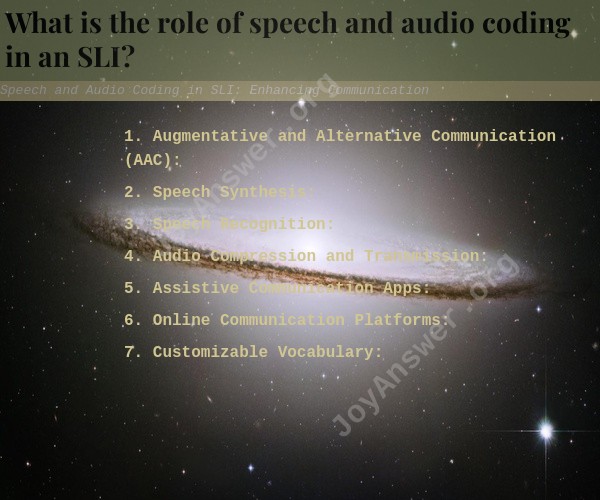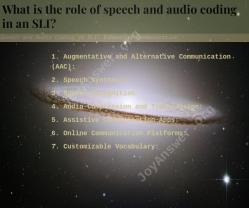What is the role of speech and audio coding in an SLI?
It seems like you're referring to "Speech and Language Impairment" (SLI), a condition that affects communication abilities, and you're interested in how speech and audio coding techniques can enhance communication for individuals with SLI. Speech and audio coding play important roles in various aspects of communication enhancement and assistive technology. Here's an overview of how these technologies can be relevant:
1. Augmentative and Alternative Communication (AAC):Individuals with SLI may have difficulty producing or comprehending speech. Augmentative and alternative communication systems use speech synthesis (coding) technology to convert text or symbols into spoken language. This allows individuals with limited speech abilities to communicate using synthesized speech output.
2. Speech Synthesis:Speech synthesis involves coding textual input into spoken output. For individuals with SLI, speech synthesis technology can help generate natural-sounding speech, aiding communication in situations where their own speech may be challenging to understand.
3. Speech Recognition:Speech recognition technology converts spoken language into text or computer-readable input. This can be beneficial for individuals with SLI by enabling them to use their speech as a means of controlling devices, composing text, or interacting with technology.
4. Audio Compression and Transmission:In cases where individuals with SLI can communicate verbally but may have difficulty with certain speech sounds or clarity, audio compression and transmission technologies can play a role. These technologies ensure that audio signals are efficiently transmitted while maintaining essential speech information.
5. Assistive Communication Apps:Many mobile applications leverage speech and audio coding to create assistive communication tools. These apps might provide customizable communication boards, predictive text, and synthesized speech output to facilitate communication for individuals with SLI.
6. Online Communication Platforms:Online platforms that support real-time communication, such as video calls or chat applications, utilize speech and audio coding to transmit spoken language across distances. These platforms can benefit individuals with SLI by allowing them to communicate remotely.
7. Customizable Vocabulary:For individuals with specific language needs or preferences, speech and audio coding technologies can be customized to reflect their vocabulary and communication style.
It's important to note that technology can greatly enhance communication for individuals with SLI, but its effectiveness can vary based on individual needs and the severity of the impairment. Working with speech-language pathologists and assistive technology specialists can help tailor solutions to each individual's unique communication challenges and abilities.



